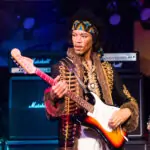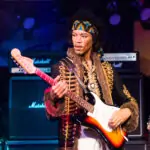Jimi Hendrix, widely regarded as one of the most influential musicians of the 20th century, redefined the sound and capabilities of the electric guitar. The Rock and Roll Hall of Fame describes him as “arguably the greatest instrumentalist in the history of rock music.” Hendrix’s sound was a unique blend of several genres and influences, showcasing his versatility and supreme talent.
Hendrix started playing guitar at age 15 and was heavily influenced by American blues, jazz, rock, and soul music. Along with his incredible guitar skills, Hendrix also had a powerful and unique singing voice.
As his career progressed, he incorporated British avant-garde rock elements into his music, producing a sound that transcended traditional genre boundaries. By fusing these various musical styles together, Jimi Hendrix was able to create a new form of rock music that can be generally identified as psychedelic rock, hard rock, and blues-rock.
Key Takeaways on What Genre Did Jimi Hendrix Play?
- Jimi Hendrix’s unique sound transcended traditional genre boundaries, fusing elements of blues, jazz, rock, and soul music.
- His innovative guitar techniques and style created a new form of rock music, which is commonly identified as psychedelic rock, hard rock, and blues-rock.
- Hendrix’s incredible talent led to lasting recognition as one of the greatest instrumentalists in the history of rock music.
You might also like these other popular posts about this iconic guitarist:
- Why is Jimi Hendrix Famous?
- How Much Was Jimi Hendrix Worth When He Died?
- Who Did Jimi Hendrix Have Children With?
Early Life and Influences
Jimi Hendrix, born Johnny Allen Hendrix, spent his early years in Seattle, where he discovered his passion for music. As a teenager, he played guitar in various bands, including The Velvetones and The Rocking Kings, where he honed his skills and began to develop his signature style.
A significant influence on Hendrix’s music was the blues, particularly artists such as Robert Johnson. He was also heavily influenced by the dynamic performances of Little Richard and admired artists like the Isley Brothers. These musical influences helped shape the young musician’s taste and style, which would later become iconic.
As a result, Jimi Hendrix’s sound can be traced back to a diverse range of genres – from the blues and rock ‘n’ roll to R&B and psychedelia – ultimately culminating in a unique and innovative fusion that resonated with audiences worldwide.
The time he spent playing with bands like the Isley Brothers provided him with valuable experience, allowing him to refine his skills and grow as a musician.
In the competitive music scene of the 1960s, Jimi Hendrix’s confidence and skill on the guitar made him stand out. His ability to synthesize various musical influences into his own signature sound allowed him to break boundaries and become an influential figure in the history of rock music.
With a rich background, Jimi Hendrix left a lasting legacy, inspiring countless musicians and redefining the possibilities of the electric guitar.
Jimi Hendrix’s Style and Impact
Jimi Hendrix was a groundbreaking musician who played a fusion of rock and blues. He was widely regarded as one of the most influential electric guitarists in history and had a significant impact on both genres. Known for his innovative guitar playing, Hendrix redefined the role of the electric guitar in popular music.
Hendrix’s style was characterized by his technical prowess, unique sound, and bold experimentation. He pushed the boundaries of what the electric guitar could achieve, introducing new techniques such as feedback and wah-wah pedals that would become staples of rock music.
In addition, Hendrix’s use of amplifiers and effects like the Octavia pedal enabled him to create a distinct, iconic tone.
Improvisation was a crucial element of Hendrix’s approach to music. His live performances often featured extended, unscripted solos that showcased his creativity and virtuosity on the guitar. This ability to captivate audiences with his free-flowing, improvised music made him a standout figure in both the rock and blues scenes.
Hendrix’s impact is also seen in the diverse range of songs he created throughout his career, from hard-hitting rock tracks like “Purple Haze” to emotive ballads such as “The Wind Cries Mary.”
His versatility as a songwriter and guitarist allowed him to explore different styles and genres while maintaining a cohesive, signature sound.
Throughout his career, Hendrix received numerous accolades for his contributions to the world of music. In 1967, he was voted the Pop Musician of the Year by Melody Maker readers, and Rolling Stone declared him the Performer of the Year in 1968. These awards affirmed Hendrix’s status as an influential figure in the arts, particularly in popular music.
Jimi Hendrix’s style and the impact he had on rock and blues music are undeniable. His innovative approach to the electric guitar, combined with his skill in improvisation and songwriting, made him a trailblazer in the world of popular music. Hendrix’s legacy as a guitarist and musician continues to inspire and influence artists today.
Career Highs and Key Performances
Jimi Hendrix, widely regarded as one of the most influential electric guitarists in the history of popular music, had a brief career that spanned only four years. Jimi Hendrix’s style combined elements of blues, jazz, rock, and soul, creating a sound that was uniquely his own.
Hendrix’s band, The Jimi Hendrix Experience, consisted of bassist Noel Redding, drummer Mitch Mitchell, and Hendrix on guitar and vocals. Together, they changed the face of rock and roll with their debut album, Are You Experienced? which featured hits like “Purple Haze” and “The Wind Cries Mary.”
In 1967, the band performed at the Monterey Pop Festival, a landmark event in the history of music. Their performance at the festival helped to catapult them to international fame.
Hendrix followed up his debut album with two more classics, “Axis: Bold as Love” and the double-album “Electric Ladyland.”
Hendrix was not only a great guitarist, but he was also a talented songwriter, and these later albums showcased his growth as a musician and his innovative approach to songwriting. The later albums displayed an exploration of different musical styles which further solidified Hendrix’s status as a rock legend.
In addition to his work with the Experience, Hendrix formed the short-lived but influential Band of Gypsys, which featured a more funk and soul-influenced sound. The band’s live performances, such as the iconic 1969 concert at the Fillmore East, are still celebrated for their raw energy and improvisational prowess.
Throughout his career, Hendrix was praised by Rolling Stone magazine, and many artists, including The Who, were influenced by his unique style and approach to the guitar. He was known for his incredible live performances, pushing the boundaries of what was possible with an electric guitar by using feedback and distortion to create new sounds.
Sadly, Jimi Hendrix’s career was cut short by his untimely death in 1970. However, his impact on the world of music continued with the posthumous release of his final studio album, “First Rays of the New Rising Sun.”
From his humble beginnings in Nashville to his groundbreaking performances on the world stage, Jimi Hendrix left an indelible mark on the history of rock and roll, and his influence can still be heard in the music of today.
Collaborations and Relationships

Jimi Hendrix, a renowned musician, made a significant impact on the music industry through his genre-bending style, often mixing elements of blues, funk, and psychedelic rock. He made a name for himself in the 1960s, initially starting his music career in New York. There, he played in bands backing artists like Little Richard and the Isley Brothers.
In 1966, Hendrix formed the Jimi Hendrix Band, which consisted of bassist Noel Redding, drummer Mitch Mitchell, and later, rhythm guitarist and bassist Billy Cox.
The band gained popularity with their unique sound and dynamic performances. Their first single, “Hey Joe,” became an instant hit and propelled them to stardom. Hendrix’s collaborations went beyond his bandmates. He had the opportunity to work with producer Eddie Kramer, who helped him further develop his sound.
Additionally, Hendrix maintained musical relationships with other prominent artists, covering songs by Bob Dylan, B.B. King, Muddy Waters, and Sam Cooke. Some of his contemporaries, such as Eric Clapton, looked up to him and were heavily influenced by his guitar skills.
Through mutual admiration, Hendrix established connections with some of the biggest names in the music industry, including the Beatles and The Who. Paul McCartney, for example, was a strong advocate of Hendrix and was instrumental in getting him to perform at the iconic Monterey Pop Festival in 1967.
Throughout his short yet influential career, Jimi Hendrix forged meaningful relationships with fellow musicians and left an indelible mark on the music landscape.
His collaborations and connections undoubtedly contributed to the development and expansion of his unique style, blending rock, blues, and psychedelic elements, which ultimately solidified his position as one of the most celebrated musicians of the 20th century.
Legacy and Recognition
Jimi Hendrix is widely regarded as one of the most influential electric guitarists in the history of rock music. His unique blending of rock, blues, and soul styles earned him a significant place in music history and inspired countless musicians who came after him.
Although Hendrix’s mainstream career spanned only four years, his impact on rock music and culture is undeniably substantial. Many credit him with revolutionizing the electric guitar and transforming the way people perceived rock and roll. As a musician, he was known for his innovative use of effects, such as the wah-wah pedal, and his incredible skill as a guitarist and singer.
Hendrix’s success as a musician can be partially attributed to his band, the Jimi Hendrix Experience. The trio included Hendrix as the lead guitarist and singer, Mitch Mitchell as the drummer, and Noel Redding as the bassist. Together, they released several highly-praised singles and albums that showcased Hendrix’s unique musicianship.
One of the most memorable moments of Hendrix’s career was his performance at the Woodstock Music & Art Fair in 1969. The iconic rendition of “The Star-Spangled Banner” showcased his mastery of the electric guitar and his ability to transcend musical boundaries. Hendrix’s legacy also extends to his work as a producer, as he was involved in designing and recording elements in his own studio.
Jimi Hendrix’s contributions to the world of music have resulted in numerous accolades and recognitions. He was posthumously inducted into the Rock and Roll Hall of Fame in 1992, with the organization recognizing him as an “architect of modern rock music.” Furthermore, his lasting influence is evident in Rolling Stone’s ranking of him as the greatest guitarist of all time.
Jimi Hendrix’s legacy and recognition are a testament to his significant impact on the world of rock music. His innovative guitar skills, blending of genres, and memorable stage presence have solidified his place among the most influential and celebrated musicians of the 20th century.
Frequently Asked Questions
What are some famous songs by Jimi Hendrix?
Jimi Hendrix has several well-known songs that showcase his unique style and skill. Some of the most famous songs include ‘Purple Haze’ and ‘The Wind Cries Mary’. These songs demonstrate his ability to combine various genres and create a distinct sound.
Who were the artists influenced by Jimi Hendrix?
Jimi Hendrix had a significant impact on many artists across different genres. His innovative approach to guitar playing and the blending of various musical styles inspired musicians like Stevie Ray Vaughan, Eric Clapton, Eddie Van Halen, and Prince.
These artists incorporated elements of Hendrix’s style into their own music, further solidifying his legacy.
How did Jimi Hendrix impact the music industry?
Jimi Hendrix’s impact on the music industry is vast, as he successfully combined American traditions of blues, jazz, rock, and soul with British avant-garde rock, redefining the electric guitar’s role within the genre.
His innovative techniques and experimentation with sounds and effects influenced a new generation of musicians and changed the way people thought about and played the guitar.
What was the primary style of blues Jimi Hendrix played?
Jimi Hendrix was a master of many genres, including blues. He played a unique style of blues rock, which combined traditional blues elements with the powerful sound of rock music. This fusion of styles allowed him to create a distinctive sound that could cater to various audiences.
What type of guitar was iconic for Jimi Hendrix?
Jimi Hendrix is famously associated with the Fender Stratocaster electric guitar. He often played a right-handed model flipped upside-down and restrung for left-handed playing since he was left-handed.
This unique approach to using the instrument not only showcased Hendrix’s versatility but also contributed to his iconic sound.
How did Jimi Hendrix’s guitar technique shape rock music?
Jimi Hendrix’s guitar technique had a profound influence on the development of rock music.
His innovative use of effects, such as distortion, feedback, and wah-wah, as well as his mastery of various playing techniques, such as fingerpicking, string bending, and vibrato, expanded the range of sounds that could be created with the electric guitar.
This innovative approach to playing the guitar continues to inspire and shape rock music to this day.

My name is Howard Matthews and I have been playing the guitar since I was knee-high. My parents like to joke that I was pulling the strings even before I was born. In fact, one of my earliest memories is sitting on the couch with my dad’s guitar, wreaking havoc on the chords.
Now, 40 years later, I can attest that I play them much better than I did back then. I have followed in the footsteps of both my parents – much to their delight – and have been the main guitarist in my band for the best part of three decades.
Music has always been my passion, and until recently my life has been so consumed with it that I haven’t had a moment to have a breath (and I wouldn’t have it any other way)!








